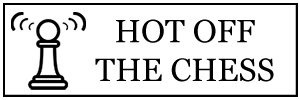
Round 7 of the Altibox Norway Chess Tournament, saw home player, Magnus Carlsen, take a big step towards winning the event for the first time. The World Champion, had a disaster here at last year’s event, of course, winning only two games and losing four, finishing on 3½-points and 7th place. In 2014 Carlsen had been pipped by a half point by Sergey Karjakin, and the same in the inaugural event in 2013.
This year is looking different. Firstly, for reasons well publicised, there is no Karjakin; but, more importantly, Carlsen seems to be playing with much more confidence and determination than he had in the previous editions of this event. An event in ones home country can bring with it all kinds of off-the-board pressures, not least from the media. Carlsen seems also to be coping with all this much better.
Carlsen had the White pieces against Vladimir Kramnik, who played the Queen’s Gambit Declined — described by Chess24’s Jan Gustafsson as “the Berlin for 1.d4”. Whether Kramnik was up for it or was seeking a quick draw, we will never know, as Carlsen had something up his sleeve. This was 12.Ne2, an invention of fellow Norwegian Grandmaster Jon Ludvig Hammer, said Carlsen.
12.Ne2 looks rather strange, but that is what one wants in a novelty of course, as one’s opponent is unlikely to have looked at it. To begin to understand it, we have to take Black’s Kingside into consideration, the doubled f-pawns and the glaring f5-square in particular. The Ne2 will be heading to g3 rather quickly, and as things stand, White will own the f5-square. In chess, one’s opponent owning any square is often most unwelcome, but for Black, a horsey on the f5-square would be most imposing.
Kramnik could not do anything about the f5-square for now, so his thought was to probably play around it and try to generate counter-play, rather than take time out trying to manoeuvre something to f5. And this indeed seemed to be his line of thinking, with the Queenside clearly being the focus of his attention — 12…Nb6, 13…Bb4+, and 14…Na4. No one can fault this approach, it is actually textbook strategic thinking.
However, the contrast in the effectiveness of the players’ piece development was already striking. Black’s pieces were not really doing very much on the Queenside, whereas White’s were looking like rabid dogs on the Kingside. This was illustrated by Carlsen’s calm 15.Ngf5 — which, rather worryingly, Kramnik said he had missed. As it was, then, nothing that Kramnik had done had in any way distracted Carlsen from his intentions, or prevented him from seizing the initiative.
This initiative steadily grew, Carlsen absolutely cementing his presence on the f5-square, and this meant that Black was virtually a piece down, his light-squared bishop so out of the game it was having to get updates from CNN … or carrier pigeon. And with his King on e6, Black was not in a position to exchange this piece any time soon, (a re-capture with the bishop would skewer King and rook of course), and so had to find another idea for freeing his position.
Kramnik opted for 19…c5 and this is a very logical move, and the one that technique and experience would say to play in 99.9% of these situations. Unfortunately, in this particular case, it didn’t help Black at all, and this is further evidence as to what trouble he was in. Carlsen’s pressure increased almost move by move, and soon his h-pawn was also running up the board, and he was threatening to smother Black’s stricken bishop altogether. Kramnik managed to exchange it, but at the cost of a pawn, after which his position was rather obliterated.
Carlsen mooched around a bit, clearly savouring the situation of having a position that he described as playing itself after move 16. “It’s pretty hard to screw it up,” he said afterwards. And this was demonstrated in the way that he converted his advantage, the point never looked in any doubt.
The other point of the day went to Levon Aronian, who won his first game of the tournament at the cost of Pavel Eljanov. The Ukranian got absolutely nothing, playing the black side of an English Opening. White had by far the more constructive setup, but did not play as optimally as he could and this gave Black the time to improve his game. Aronian’s 18.d4 was a little bit out of context, but the Armenian Grandmaster obviously wanted to take advantage of Black’s Queen being inadequately defended on c8, which meant that exchanging …cxd4 was not an option. Eljanov targeted White’s dark-squared bishop, however, with 18…Ng6 and this was a piece that White very much wanted to hang on to.
19.Be3 was probably a better way of doing this, however, than Aronian’s 19.Bg5. All of a sudden, Black had generated (or been handed,) some play. Potentially anyway. The reason for this is that 19…Nxe4 is now a serious option, due to the g5-bishop. Had the bishop gone to e3, then after …Nxe4, dxc5 would see the piece en prise and Black is in an awkward spot. However, White’s Bishop being on the g5-square, means that 19…Nxe4 is perfectly valid. The most likely continuation would be 20.Bxe7 (dxc5 simply leaves …Nxg5 of course) …Nxe7 and Black is actually doing rather nicely.
And this makes it rather surprising that Eljanov opted for the 19…a6, which was very quiet in comparison. After 20.Nc3, White was fine, especially after Black’s 22…c4 (…cxd4 was probably more testing). From here, the players focussed on opposite wings, White thrusting his h-pawn, and Black with b and c pawns. The problem for Eljanov, however, was that his pawns just did not get moving until it was too late. Aronian had a nice bind on the Kingside, and converted the point without any difficulty, penetrating the Black position with his Queen and adding a central passed pawn.
The other games were drawn, including a marathon 93-mover from Nils Grandelius and Li Chao. White was constantly ahead in their Caro-Kann, but the position was largely closed and there just seemed no way through. I think Grandelius will be somewhat disappointed not to have achieved the full point. Pentala Harikrishna and Maxime Vachier-Lagrave also got in to a game which saw White initially better but let things slip. 38…c5? Was inaccurate and gave Black the initiative, but the game ended up drawn in 49.
Topalov-Giri was also drawn when neither player was able to generate anything. Black chucked his Queen for a bishop in the end, but this was only for a perpetual.
Standings after 7 rounds:
Carlsen — 5
Vachier-Lagrave, Aronian, Topalov, Harikrishna — 4
Kramnik — 3½
Giri, Li Chao, Eljanov — 3
Grandelius — 1½
Round 8: Thursday 28th April
Aronian-Carlsen
Eljanov-Li Chao
Vachier-Lagrave—Topalov
Kramnik-Harikrishna
Giri-Grandelius
Play begins at 16:00 local time. If you need to, you can check your time, here.
More Information: Atibox Norway Chess 2016 Website

